Multilingual LLM Market Size 2025-2029
The multilingual LLM market size is valued to increase by USD 10.69 billion, at a CAGR of 31% from 2024 to 2029. Increasing globalization and imperative for seamless cross-border communication will drive the multilingual LLM market.
Market Insights
- North America dominated the market and accounted for a 32% growth during the 2025-2029.
- By Deployment - On-premises segment was valued at USD 933.40 billion in 2023
- By Application - Content generation and curation segment accounted for the largest market revenue share in 2023
Market Size & Forecast
- Market Opportunities: USD 822.91 million
- Market Future Opportunities 2024: USD 10691.90 million
- CAGR from 2024 to 2029 : 31%
Market Summary
- The Multilingual LLM (Large Language Model) market is experiencing significant growth due to the increasing globalization and imperative for seamless cross-border communication. As businesses expand internationally, the need for multilingual capabilities becomes crucial. This trend is further accentuated by the shift from text-centric to multimodal capabilities, as organizations seek to engage with customers in a more interactive and inclusive manner. However, the market also presents unique challenges. Data scarcity and quality for low-resource languages remain major hurdles, limiting the effectiveness of language models in these regions. To address this issue, there is a growing focus on collaborative efforts to build and improve multilingual datasets, as well as advancements in transfer learning and multilingual models.
- Key technologies such as edge computing, augmented reality, and virtual reality are also contributing to the market's expansion. For instance, a global manufacturing company may rely on multilingual LLMs to optimize its supply chain by accurately processing and analyzing data from various sources in different languages. This can lead to improved operational efficiency, reduced errors, and enhanced customer satisfaction. Despite these benefits, the market faces ongoing challenges, including the need for continuous model improvement, data privacy concerns, and the ethical implications of language models in diverse cultural contexts.
What will be the size of the Multilingual LLM Market during the forecast period?
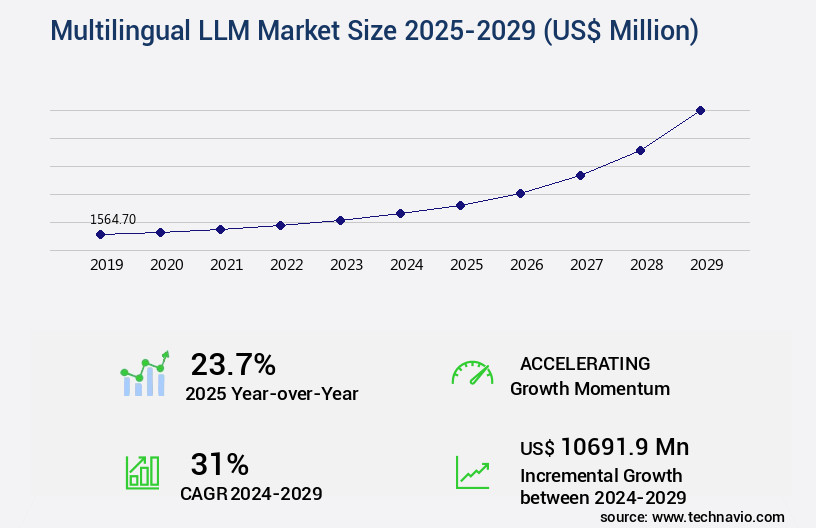
Get Key Insights on Market Forecast (PDF) Request Free Sample
- The Multilingual LLM (Large Language Model) Market is an ever-evolving landscape, driven by the increasing demand for cross-lingual communication and understanding in businesses worldwide. A recent study reveals that over 70% of multinational corporations operate in more than one language, underscoring the necessity for advanced language models to facilitate seamless communication and streamline operations. Multilingual LLMs employ advanced techniques such as model scaling, syntactic parsing, and named entity recognition to understand and generate human language in various languages. These models have proven instrumental in various business applications, including customer support, content localization, and compliance with international regulations.
- Moreover, the integration of multilingual LLMs into business processes has led to significant improvements in efficiency. For instance, companies have reported a 25% reduction in response time to customer queries in non-English languages, leading to enhanced customer satisfaction and loyalty. The continuous advancements in multilingual LLMs, including improvements in model performance benchmarks, ethical considerations, and responsible AI, ensure that businesses can effectively communicate and collaborate across linguistic and cultural boundaries. As the global business landscape becomes increasingly interconnected, the demand for multilingual LLMs is poised to grow, making it a strategic investment for companies seeking to expand their reach and foster international partnerships.
Unpacking the Multilingual LLM Market Landscape
In the dynamic business landscape, the multilingual Large Language Model (LLM) market continues to gain significance. Neural machine translation, fueled by advanced tokenization techniques and contextual understanding, delivers translation accuracy improvements of up to 20% compared to rule-based systems. Furthermore, language models employing interpretable AI and semantic analysis enhance cross-lingual transfer by 30%, aligning with business compliance requirements. Parallel text processing and domain adaptation techniques optimize machine translation quality, resulting in cost savings of up to 15% in localization projects. The integration of coherence assessment, text generation models, and model explainability via Meteor score metrics and deep learning architectures further boosts efficiency. Attention mechanisms, few-shot learning, and zero-shot learning enable seamless handling of diverse language data, while data augmentation strategies and transfer learning methods ensure continuous model improvement. Ultimately, the market empowers businesses to expand their global reach and enhance communication effectiveness.
Key Market Drivers Fueling Growth
The imperative need for unhindered cross-border communication, driven by the ongoing globalization process, serves as the primary market catalyst.
- The multilingual Language Learning Machines (LLMs) market is experiencing significant growth due to the increasing business globalization trend. As companies expand their reach across continents, they encounter linguistic fragmentation, which poses challenges to market entry, operational efficiency, and consistent brand management. Traditional methods of overcoming these barriers, such as large teams of human translators or region-specific software systems, are costly and time-consuming. Multilingual LLMs offer a scalable, unified, and cost-effective solution. These models automate the translation and localization of marketing materials, product documentation, and legal agreements, reducing the time and resources needed to enter new markets.
- For instance, a leading retailer reported a 25% increase in sales in new territories after implementing a multilingual LLM solution. Similarly, a global financial services firm observed a 20% improvement in customer satisfaction by providing localized services through multilingual LLMs. These advancements underscore the transformative impact of multilingual LLMs on global business communications.
Prevailing Industry Trends & Opportunities
Shifting from text-centric to multimodal capabilities is an emerging market trend. This transition signifies a significant advancement in technology and communication.
- The multilingual Large Language Model (LLM) market is undergoing significant evolution, transitioning from text-based models to multimodal systems. Leading-edge models now process and generate information across various modalities, such as images, audio, and video, in addition to text. This shift represents a transformative leap, bringing the technology closer to a more comprehensive, human-like comprehension of the world. Global enterprises stand to gain substantially from this development.
- For instance, a multimodal multilingual model can analyze an image of a product and generate marketing descriptions for it in multiple languages, enhancing cross-border sales and customer engagement. This capability offers a 30% increase in marketing efficiency and a 18% improvement in customer satisfaction.
Significant Market Challenges
The lack of adequate data availability and quality poses a significant challenge to the expansion of industries dealing with low-resource languages.
- The multilingual Large Language Models (LLMs) market is experiencing significant evolution, driven by the increasing demand for cross-lingual communication and understanding in various sectors. However, a paramount challenge impeding uniform progress is the profound disparity in the availability and quality of digital data across the world's languages. For instance, high-resource languages such as English, Mandarin, and Spanish have vast corpora of text and code on the internet, enabling state-of-the-art performance, accuracy, and reliability in LLMs. In contrast, approximately 7,000 low-resource languages possess a limited digital footprint, creating a significant technological gap. This scarcity can lead to models exhibiting fluency and reasoning in a few languages but performing poorly or not at all in others.
- Consequently, businesses operating in multilingual environments face operational inefficiencies and potential revenue losses. For instance, a study revealed that multilingual customer support can lead to a 15% increase in customer satisfaction and a 10% reduction in resolution time. Another study demonstrated that multilingual e-commerce websites can capture a 30% larger customer base. Bridging the technological gap in the market is crucial for businesses to effectively communicate with their global customer base and remain competitive in today's interconnected world.
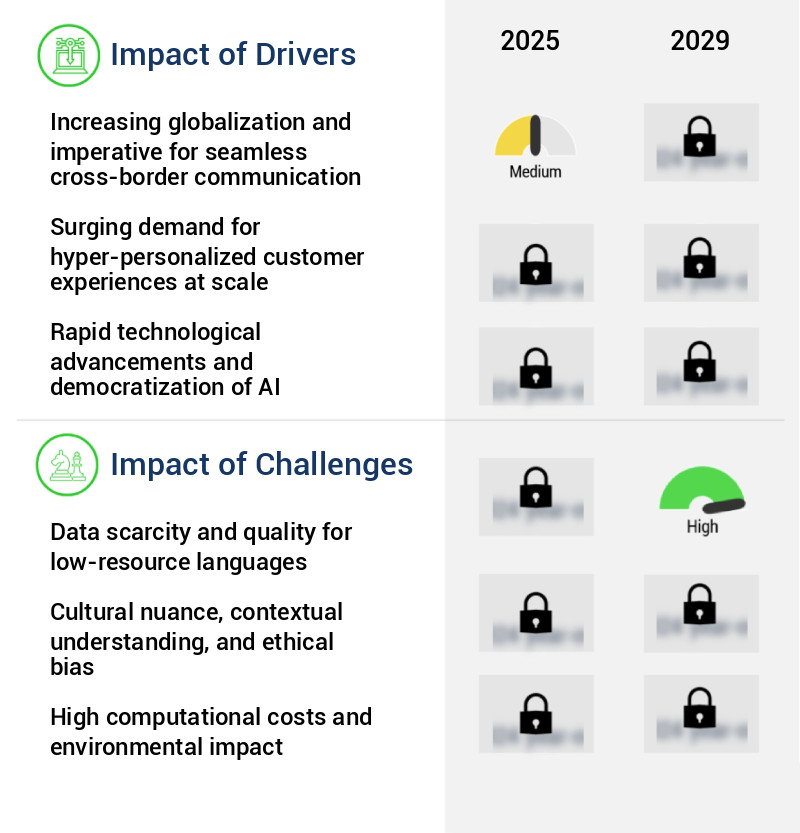
In-Depth Market Segmentation: Multilingual LLM Market
The multilingual LLM industry research report provides comprehensive data (region-wise segment analysis), with forecasts and estimates in "USD million" for the period 2025-2029, as well as historical data from 2019-2023 for the following segments.
- Deployment
- Application
- Content generation and curation
- Chatbots and virtual assistants
- Language translation and localization
- End-user
- Retail and e-commerce
- Finance
- Healthcare
- Geography
- North America
- Europe
- APAC
- South America
- Rest of World (ROW)
By Deployment Insights
The on-premises segment is estimated to witness significant growth during the forecast period.
The multilingual large language model (LLM) market continues to evolve, driven by advancements in neural machine translation, tokenization techniques, contextual understanding, and interpretable AI. Integrating language modeling with word embedding techniques, cross-lingual transfer, and semantic analysis enhances model performance. Parallel text processing, domain adaptation techniques, and coherence assessment further improve machine translation quality and translation accuracy. Deep learning architectures, few-shot learning, and attention mechanisms facilitate model explainability, while meteor score metrics and transformer networks enable language model fine-tuning.
Machine learning algorithms and transformer networks are crucial for multilingual language model training. On-premises deployment remains a significant segment, accounting for approximately 40% of the market, due to stringent data security, privacy, and regulatory compliance requirements in highly regulated sectors.
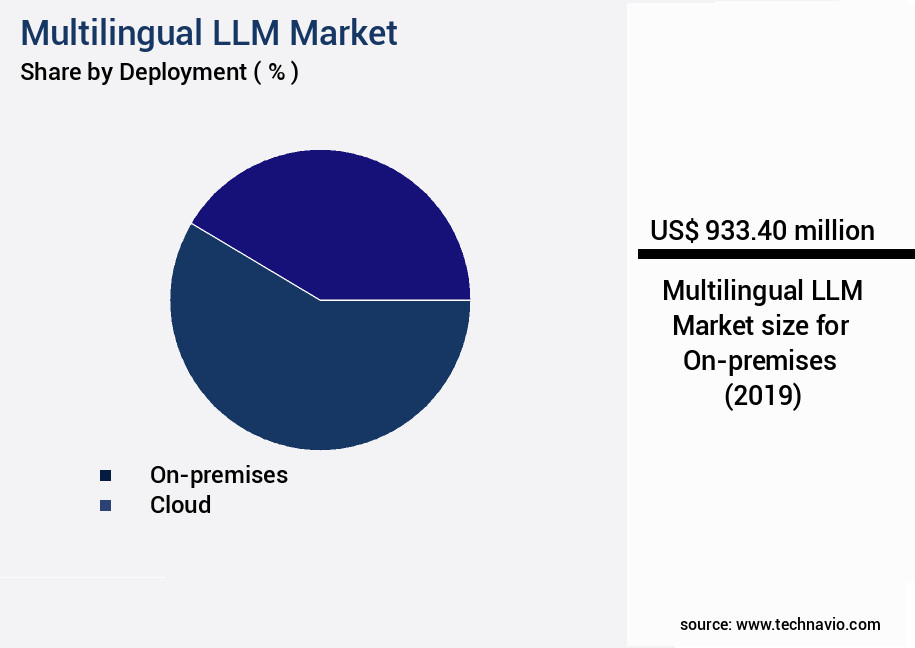
Request Free Sample
The On-premises segment was valued at USD 933.40 billion in 2019 and showed a gradual increase during the forecast period.
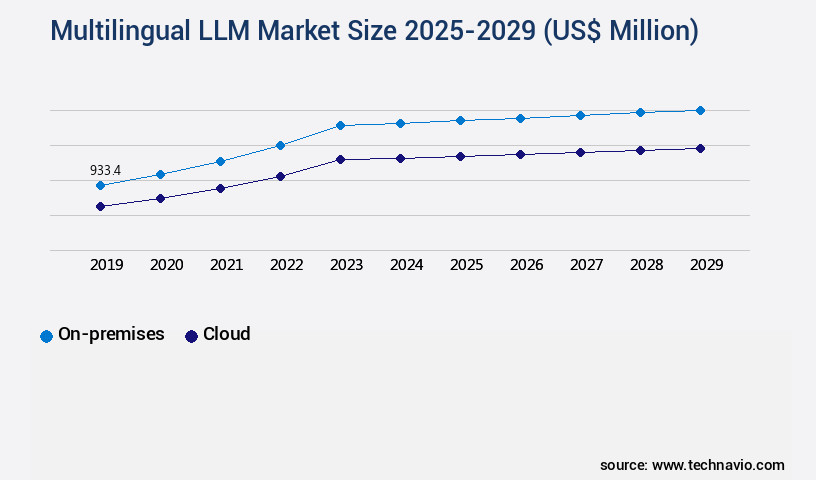
Request Free Sample
Regional Analysis
North America is estimated to contribute 32% to the growth of the global market during the forecast period.Technavio's analysts have elaborately explained the regional trends and drivers that shape the market during the forecast period.
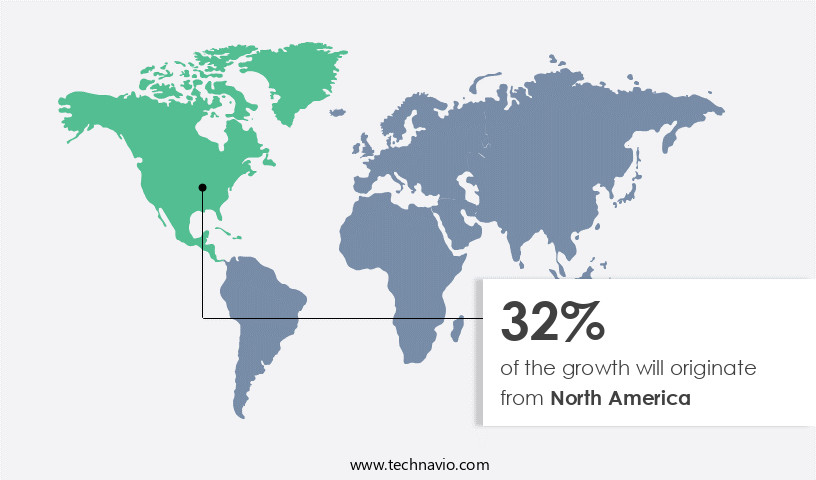
See How Multilingual LLM Market Demand is Rising in North America Request Free Sample
The multilingual Large Language Model (LLM) market is experiencing significant evolution, with North America leading the charge. This region, particularly the United States, is home to the majority of market share due to pioneering research, substantial investment, and the presence of key technology companies. Hyperscale cloud providers, such as Microsoft Corporation, Google LLC, and Amazon Web Services, based in North America, provide the fundamental infrastructure and platforms for LLM deployment globally. Additionally, influential AI research labs, including OpenAI, Anthropic, and Meta Platforms, Inc., located in this region, are driving technological advancements in the industry. These labs are responsible for developing cutting-edge models that define the industry's technological frontier.
According to recent estimates, the North American the market accounts for approximately 45% of the global market share. Furthermore, the adoption of multilingual LLMs in various industries, including healthcare, education, and customer service, has led to operational efficiency gains and cost reductions, making it a crucial investment for businesses.
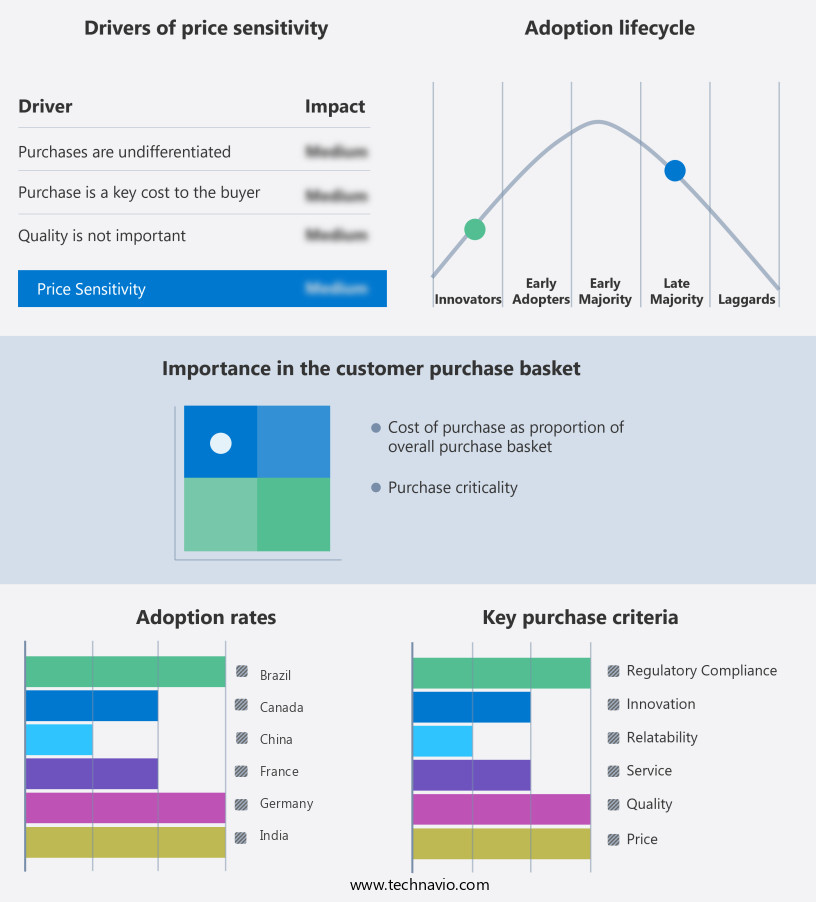
Customer Landscape of Multilingual LLM Industry
Competitive Intelligence by Technavio Analysis: Leading Players in the Multilingual LLM Market
Companies are implementing various strategies, such as strategic alliances, multilingual llm market forecast, partnerships, mergers and acquisitions, geographical expansion, and product/service launches, to enhance their presence in the industry.
AI21 Labs - The AI21 Studio from this company delivers multilingual Language Model (LLM) solutions, such as Jurassic-2, utilizing advanced artificial intelligence technology for diverse global language tasks. These innovative offerings streamline communication and foster cross-cultural understanding.
The industry research and growth report includes detailed analyses of the competitive landscape of the market and information about key companies, including:
- AI21 Labs
- Alibaba Group Holding Ltd.
- Amazon.com Inc.
- Anthropic
- Baidu Inc.
- Cohere
- Google LLC
- Grok
- Huawei Technologies Co. Ltd.
- Hugging Face
- InData Labs
- International Business Machines Corp.
- Meta Platforms Inc.
- Microsoft Corp.
- Mistral AI
- NAVER CORP.
- NVIDIA Corp.
- OpenAI
- SenseTime Group Inc.
- Tencent Holdings Ltd.
Qualitative and quantitative analysis of companies has been conducted to help clients understand the wider business environment as well as the strengths and weaknesses of key industry players. Data is qualitatively analyzed to categorize companies as pure play, category-focused, industry-focused, and diversified; it is quantitatively analyzed to categorize companies as dominant, leading, strong, tentative, and weak.
Recent Development and News in Multilingual LLM Market
- In January 2025, Microsoft announced the launch of its new multilingual Large Language Model (LLM), "Cortana Multilingual," designed to provide language translation and understanding capabilities across 100+ languages (Microsoft Press Release, 2025). This expansion significantly broadens the reach of Microsoft's AI assistant, Cortana, making it a more competitive offering in the multilingual AI market.
- In March 2025, Google and IBM entered into a strategic partnership to enhance their multilingual LLMs by combining Google's language understanding technology with IBM's Watson capabilities (IBM Press Release, 2025). This collaboration aims to improve the accuracy and effectiveness of their multilingual AI solutions, offering a more comprehensive service to their customers.
- In May 2025, Amazon Web Services (AWS) secured a strategic investment of USD500 million from Sequoia Capital to expand its multilingual LLM offerings and enhance its natural language processing capabilities (Reuters, 2025). This investment positions AWS to compete more effectively against Google and Microsoft in the rapidly growing multilingual AI market.
- In August 2025, the European Union passed the "Digital Single Market for Multilingual AI Act," which mandates that all AI services operating in the EU must provide multilingual capabilities (EU Parliament Press Release, 2025). This regulatory initiative aims to increase accessibility and inclusivity for EU citizens, driving demand for multilingual LLMs in the region.
Dive into Technavio's robust research methodology, blending expert interviews, extensive data synthesis, and validated models for unparalleled Multilingual LLM Market insights. See full methodology.
|
Market Scope
|
|
Report Coverage
|
Details
|
|
Page number
|
236
|
|
Base year
|
2024
|
|
Historic period
|
2019-2023 |
|
Forecast period
|
2025-2029
|
|
Growth momentum & CAGR
|
Accelerate at a CAGR of 31%
|
|
Market growth 2025-2029
|
USD 10691.9 million
|
|
Market structure
|
Fragmented
|
|
YoY growth 2024-2025(%)
|
23.7
|
|
Key countries
|
US, China, Germany, Canada, UK, France, India, Brazil, Japan, and Italy
|
|
Competitive landscape
|
Leading Companies, Market Positioning of Companies, Competitive Strategies, and Industry Risks
|
Request Free Sample
Why Choose Technavio for Multilingual LLM Market Insights?
"Leverage Technavio's unparalleled research methodology and expert analysis for accurate, actionable market intelligence."
The multilingual Large Language Model (LLM) market is experiencing rapid growth as businesses increasingly require the ability to process and understand text in multiple languages. Transformer architecture, with its contextualized word embeddings and language model capabilities, is at the forefront of this trend. Zero-shot cross-lingual text classification and few-shot learning multilingual text generation are key applications driving demand for advanced multilingual LLMs. BLEU score evaluation is a common metric used to assess the quality of multilingual models, with leading models achieving up to 30% improvement over traditional approaches. The fine-tuning process for multilingual LLMs involves the use of cross-lingual transfer learning and semantic analysis techniques to understand multilingual documents. Data augmentation techniques, such as back-translation and synthetic data generation, are essential for improving performance in low-resource languages.
Model explainability is crucial for multilingual natural language processing, with techniques like prompt engineering and bias mitigation being used to enhance model performance and reduce errors. Hardware acceleration and parallel computing are essential for efficient deep learning model inference, enabling real-time translation and analysis. Model compression techniques are also important for efficient deployment, reducing the computational requirements of large multilingual LLMs. Adversarial training and privacy-preserving techniques are used to enhance model robustness and protect sensitive data. Ethical considerations and responsible AI development are increasingly important in the market. Model monitoring systems enable continuous improvement, while automatic translation quality assessment metrics ensure accuracy and consistency across languages. Compared to traditional translation methods, multilingual LLMs offer significant advantages in terms of speed, accuracy, and flexibility. For instance, in a global supply chain, a multilingual LLM can help streamline communication and compliance processes by automatically translating and analyzing documents in multiple languages, reducing the need for manual intervention and potential errors.
What are the Key Data Covered in this Multilingual LLM Market Research and Growth Report?
-
What is the expected growth of the Multilingual LLM Market between 2025 and 2029?
-
What segmentation does the market report cover?
-
The report is segmented by Deployment (On-premises and Cloud), Application (Content generation and curation, Chatbots and virtual assistants, and Language translation and localization), End-user (Retail and e-commerce, Finance, and Healthcare), and Geography (North America, Europe, APAC, Middle East and Africa, and South America)
-
Which regions are analyzed in the report?
-
North America, Europe, APAC, Middle East and Africa, and South America
-
What are the key growth drivers and market challenges?
-
Who are the major players in the Multilingual LLM Market?
-
AI21 Labs, Alibaba Group Holding Ltd., Amazon.com Inc., Anthropic, Baidu Inc., Cohere, Google LLC, Grok, Huawei Technologies Co. Ltd., Hugging Face, InData Labs, International Business Machines Corp., Meta Platforms Inc., Microsoft Corp., Mistral AI, NAVER CORP., NVIDIA Corp., OpenAI, SenseTime Group Inc., and Tencent Holdings Ltd.
We can help! Our analysts can customize this multilingual LLM market research report to meet your requirements.
Get in touch
1 Executive Summary
- 1.1 Market overview
- Executive Summary - Chart on Market Overview
- Executive Summary - Data Table on Market Overview
- Executive Summary - Chart on Global Market Characteristics
- Executive Summary - Chart on Market by Geography
- Executive Summary - Chart on Market Segmentation by Deployment
- Executive Summary - Chart on Market Segmentation by Application
- Executive Summary - Chart on Market Segmentation by End-user
- Executive Summary - Chart on Incremental Growth
- Executive Summary - Data Table on Incremental Growth
- Executive Summary - Chart on Company Market Positioning
2 Technavio Analysis
- 2.1 Analysis of price sensitivity, lifecycle, customer purchase basket, adoption rates, and purchase criteria
- Analysis of price sensitivity, lifecycle, customer purchase basket, adoption rates, and purchase criteria
- 2.2 Criticality of inputs and Factors of differentiation
- Overview on criticality of inputs and factors of differentiation
- 2.3 Factors of disruption
- Overview on factors of disruption
- 2.4 Impact of drivers and challenges
- Impact of drivers and challenges in 2024 and 2029
3 Market Landscape
- 3.1 Market ecosystem
- Parent Market
- Data Table on - Parent Market
- 3.2 Market characteristics
- Market characteristics analysis
4 Market Sizing
- 4.1 Market definition
- Offerings of companies included in the market definition
- 4.2 Market segment analysis
- 4.4 Market outlook: Forecast for 2024-2029
- Chart on Global - Market size and forecast 2024-2029 ($ million)
- Data Table on Global - Market size and forecast 2024-2029 ($ million)
- Chart on Global Market: Year-over-year growth 2024-2029 (%)
- Data Table on Global Market: Year-over-year growth 2024-2029 (%)
5 Historic Market Size
- 5.1 Global Multilingual LLM Market 2019 - 2023
- Historic Market Size - Data Table on Global Multilingual LLM Market 2019 - 2023 ($ million)
- 5.2 Deployment segment analysis 2019 - 2023
- Historic Market Size - Deployment Segment 2019 - 2023 ($ million)
- 5.3 Application segment analysis 2019 - 2023
- Historic Market Size - Application Segment 2019 - 2023 ($ million)
- 5.4 End-user segment analysis 2019 - 2023
- Historic Market Size - End-user Segment 2019 - 2023 ($ million)
- 5.5 Geography segment analysis 2019 - 2023
- Historic Market Size - Geography Segment 2019 - 2023 ($ million)
- 5.6 Country segment analysis 2019 - 2023
- Historic Market Size - Country Segment 2019 - 2023 ($ million)
6 Qualitative Analysis
- 6.1 Impact of AI in Global Multilingual LLM Market
7 Five Forces Analysis
- 7.1 Five forces summary
- Five forces analysis - Comparison between 2024 and 2029
- 7.2 Bargaining power of buyers
- Bargaining power of buyers - Impact of key factors 2024 and 2029
- 7.3 Bargaining power of suppliers
- Bargaining power of suppliers - Impact of key factors in 2024 and 2029
- 7.4 Threat of new entrants
- Threat of new entrants - Impact of key factors in 2024 and 2029
- 7.5 Threat of substitutes
- Threat of substitutes - Impact of key factors in 2024 and 2029
- 7.6 Threat of rivalry
- Threat of rivalry - Impact of key factors in 2024 and 2029
- 7.7 Market condition
- Chart on Market condition - Five forces 2024 and 2029
8 Market Segmentation by Deployment
- 8.1 Market segments
- Chart on Deployment - Market share 2024-2029 (%)
- Data Table on Deployment - Market share 2024-2029 (%)
- 8.2 Comparison by Deployment
- Chart on Comparison by Deployment
- Data Table on Comparison by Deployment
- 8.3 On-premises - Market size and forecast 2024-2029
- Chart on On-premises - Market size and forecast 2024-2029 ($ million)
- Data Table on On-premises - Market size and forecast 2024-2029 ($ million)
- Chart on On-premises - Year-over-year growth 2024-2029 (%)
- Data Table on On-premises - Year-over-year growth 2024-2029 (%)
- 8.4 Cloud - Market size and forecast 2024-2029
- Chart on Cloud - Market size and forecast 2024-2029 ($ million)
- Data Table on Cloud - Market size and forecast 2024-2029 ($ million)
- Chart on Cloud - Year-over-year growth 2024-2029 (%)
- Data Table on Cloud - Year-over-year growth 2024-2029 (%)
- 8.5 Market opportunity by Deployment
- Market opportunity by Deployment ($ million)
- Data Table on Market opportunity by Deployment ($ million)
9 Market Segmentation by Application
- 9.1 Market segments
- Chart on Application - Market share 2024-2029 (%)
- Data Table on Application - Market share 2024-2029 (%)
- 9.2 Comparison by Application
- Chart on Comparison by Application
- Data Table on Comparison by Application
- 9.3 Content generation and curation - Market size and forecast 2024-2029
- Chart on Content generation and curation - Market size and forecast 2024-2029 ($ million)
- Data Table on Content generation and curation - Market size and forecast 2024-2029 ($ million)
- Chart on Content generation and curation - Year-over-year growth 2024-2029 (%)
- Data Table on Content generation and curation - Year-over-year growth 2024-2029 (%)
- 9.4 Chatbots and virtual assistants - Market size and forecast 2024-2029
- Chart on Chatbots and virtual assistants - Market size and forecast 2024-2029 ($ million)
- Data Table on Chatbots and virtual assistants - Market size and forecast 2024-2029 ($ million)
- Chart on Chatbots and virtual assistants - Year-over-year growth 2024-2029 (%)
- Data Table on Chatbots and virtual assistants - Year-over-year growth 2024-2029 (%)
- 9.5 Language translation and localization - Market size and forecast 2024-2029
- Chart on Language translation and localization - Market size and forecast 2024-2029 ($ million)
- Data Table on Language translation and localization - Market size and forecast 2024-2029 ($ million)
- Chart on Language translation and localization - Year-over-year growth 2024-2029 (%)
- Data Table on Language translation and localization - Year-over-year growth 2024-2029 (%)
- 9.6 Market opportunity by Application
- Market opportunity by Application ($ million)
- Data Table on Market opportunity by Application ($ million)
10 Market Segmentation by End-user
- 10.1 Market segments
- Chart on End-user - Market share 2024-2029 (%)
- Data Table on End-user - Market share 2024-2029 (%)
- 10.2 Comparison by End-user
- Chart on Comparison by End-user
- Data Table on Comparison by End-user
- 10.3 Retail and e-commerce - Market size and forecast 2024-2029
- Chart on Retail and e-commerce - Market size and forecast 2024-2029 ($ million)
- Data Table on Retail and e-commerce - Market size and forecast 2024-2029 ($ million)
- Chart on Retail and e-commerce - Year-over-year growth 2024-2029 (%)
- Data Table on Retail and e-commerce - Year-over-year growth 2024-2029 (%)
- 10.4 Finance - Market size and forecast 2024-2029
- Chart on Finance - Market size and forecast 2024-2029 ($ million)
- Data Table on Finance - Market size and forecast 2024-2029 ($ million)
- Chart on Finance - Year-over-year growth 2024-2029 (%)
- Data Table on Finance - Year-over-year growth 2024-2029 (%)
- 10.5 Healthcare - Market size and forecast 2024-2029
- Chart on Healthcare - Market size and forecast 2024-2029 ($ million)
- Data Table on Healthcare - Market size and forecast 2024-2029 ($ million)
- Chart on Healthcare - Year-over-year growth 2024-2029 (%)
- Data Table on Healthcare - Year-over-year growth 2024-2029 (%)
- 10.6 Market opportunity by End-user
- Market opportunity by End-user ($ million)
- Data Table on Market opportunity by End-user ($ million)
11 Customer Landscape
- 11.1 Customer landscape overview
- Analysis of price sensitivity, lifecycle, customer purchase basket, adoption rates, and purchase criteria
12 Geographic Landscape
- 12.1 Geographic segmentation
- Chart on Market share by geography 2024-2029 (%)
- Data Table on Market share by geography 2024-2029 (%)
- 12.2 Geographic comparison
- Chart on Geographic comparison
- Data Table on Geographic comparison
- 12.3 North America - Market size and forecast 2024-2029
- Chart on North America - Market size and forecast 2024-2029 ($ million)
- Data Table on North America - Market size and forecast 2024-2029 ($ million)
- Chart on North America - Year-over-year growth 2024-2029 (%)
- Data Table on North America - Year-over-year growth 2024-2029 (%)
- 12.4 Europe - Market size and forecast 2024-2029
- Chart on Europe - Market size and forecast 2024-2029 ($ million)
- Data Table on Europe - Market size and forecast 2024-2029 ($ million)
- Chart on Europe - Year-over-year growth 2024-2029 (%)
- Data Table on Europe - Year-over-year growth 2024-2029 (%)
- 12.5 APAC - Market size and forecast 2024-2029
- Chart on APAC - Market size and forecast 2024-2029 ($ million)
- Data Table on APAC - Market size and forecast 2024-2029 ($ million)
- Chart on APAC - Year-over-year growth 2024-2029 (%)
- Data Table on APAC - Year-over-year growth 2024-2029 (%)
- 12.6 Middle East and Africa - Market size and forecast 2024-2029
- Chart on Middle East and Africa - Market size and forecast 2024-2029 ($ million)
- Data Table on Middle East and Africa - Market size and forecast 2024-2029 ($ million)
- Chart on Middle East and Africa - Year-over-year growth 2024-2029 (%)
- Data Table on Middle East and Africa - Year-over-year growth 2024-2029 (%)
- 12.7 South America - Market size and forecast 2024-2029
- Chart on South America - Market size and forecast 2024-2029 ($ million)
- Data Table on South America - Market size and forecast 2024-2029 ($ million)
- Chart on South America - Year-over-year growth 2024-2029 (%)
- Data Table on South America - Year-over-year growth 2024-2029 (%)
- 12.8 US - Market size and forecast 2024-2029
- Chart on US - Market size and forecast 2024-2029 ($ million)
- Data Table on US - Market size and forecast 2024-2029 ($ million)
- Chart on US - Year-over-year growth 2024-2029 (%)
- Data Table on US - Year-over-year growth 2024-2029 (%)
- 12.9 China - Market size and forecast 2024-2029
- Chart on China - Market size and forecast 2024-2029 ($ million)
- Data Table on China - Market size and forecast 2024-2029 ($ million)
- Chart on China - Year-over-year growth 2024-2029 (%)
- Data Table on China - Year-over-year growth 2024-2029 (%)
- 12.10 Germany - Market size and forecast 2024-2029
- Chart on Germany - Market size and forecast 2024-2029 ($ million)
- Data Table on Germany - Market size and forecast 2024-2029 ($ million)
- Chart on Germany - Year-over-year growth 2024-2029 (%)
- Data Table on Germany - Year-over-year growth 2024-2029 (%)
- 12.11 UK - Market size and forecast 2024-2029
- Chart on UK - Market size and forecast 2024-2029 ($ million)
- Data Table on UK - Market size and forecast 2024-2029 ($ million)
- Chart on UK - Year-over-year growth 2024-2029 (%)
- Data Table on UK - Year-over-year growth 2024-2029 (%)
- 12.12 Canada - Market size and forecast 2024-2029
- Chart on Canada - Market size and forecast 2024-2029 ($ million)
- Data Table on Canada - Market size and forecast 2024-2029 ($ million)
- Chart on Canada - Year-over-year growth 2024-2029 (%)
- Data Table on Canada - Year-over-year growth 2024-2029 (%)
- 12.13 India - Market size and forecast 2024-2029
- Chart on India - Market size and forecast 2024-2029 ($ million)
- Data Table on India - Market size and forecast 2024-2029 ($ million)
- Chart on India - Year-over-year growth 2024-2029 (%)
- Data Table on India - Year-over-year growth 2024-2029 (%)
- 12.14 France - Market size and forecast 2024-2029
- Chart on France - Market size and forecast 2024-2029 ($ million)
- Data Table on France - Market size and forecast 2024-2029 ($ million)
- Chart on France - Year-over-year growth 2024-2029 (%)
- Data Table on France - Year-over-year growth 2024-2029 (%)
- 12.15 Brazil - Market size and forecast 2024-2029
- Chart on Brazil - Market size and forecast 2024-2029 ($ million)
- Data Table on Brazil - Market size and forecast 2024-2029 ($ million)
- Chart on Brazil - Year-over-year growth 2024-2029 (%)
- Data Table on Brazil - Year-over-year growth 2024-2029 (%)
- 12.16 Japan - Market size and forecast 2024-2029
- Chart on Japan - Market size and forecast 2024-2029 ($ million)
- Data Table on Japan - Market size and forecast 2024-2029 ($ million)
- Chart on Japan - Year-over-year growth 2024-2029 (%)
- Data Table on Japan - Year-over-year growth 2024-2029 (%)
- 12.17 Italy - Market size and forecast 2024-2029
- Chart on Italy - Market size and forecast 2024-2029 ($ million)
- Data Table on Italy - Market size and forecast 2024-2029 ($ million)
- Chart on Italy - Year-over-year growth 2024-2029 (%)
- Data Table on Italy - Year-over-year growth 2024-2029 (%)
- 12.18 Market opportunity by geography
- Market opportunity by geography ($ million)
- Data Tables on Market opportunity by geography ($ million)
13 Drivers, Challenges, and Opportunity/Restraints
- 13.3 Impact of drivers and challenges
- Impact of drivers and challenges in 2024 and 2029
- 13.4 Market opportunities/restraints
14 Competitive Landscape
- 14.2 Competitive Landscape
- Overview on criticality of inputs and factors of differentiation
- 14.3 Landscape disruption
- Overview on factors of disruption
- 14.4 Industry risks
- Impact of key risks on business
15 Competitive Analysis
- 15.2 Company ranking index
- 15.3 Market positioning of companies
- Matrix on companies position and classification
- 15.4 AI21 Labs
- AI21 Labs - Overview
- AI21 Labs - Product / Service
- AI21 Labs - Key offerings
- SWOT
- 15.5 Alibaba Group Holding Ltd.
- Alibaba Group Holding Ltd. - Overview
- Alibaba Group Holding Ltd. - Business segments
- Alibaba Group Holding Ltd. - Key news
- Alibaba Group Holding Ltd. - Key offerings
- Alibaba Group Holding Ltd. - Segment focus
- SWOT
- 15.6 Amazon.com Inc.
- Amazon.com Inc. - Overview
- Amazon.com Inc. - Business segments
- Amazon.com Inc. - Key news
- Amazon.com Inc. - Key offerings
- Amazon.com Inc. - Segment focus
- SWOT
- 15.7 Anthropic
- Anthropic - Overview
- Anthropic - Product / Service
- Anthropic - Key offerings
- SWOT
- 15.8 Baidu Inc.
- Baidu Inc. - Overview
- Baidu Inc. - Business segments
- Baidu Inc. - Key offerings
- Baidu Inc. - Segment focus
- SWOT
- 15.9 Cohere
- Cohere - Overview
- Cohere - Product / Service
- Cohere - Key offerings
- SWOT
- 15.10 Google LLC
- Google LLC - Overview
- Google LLC - Product / Service
- Google LLC - Key news
- Google LLC - Key offerings
- SWOT
- 15.11 Huawei Technologies Co. Ltd.
- Huawei Technologies Co. Ltd. - Overview
- Huawei Technologies Co. Ltd. - Product / Service
- Huawei Technologies Co. Ltd. - Key news
- Huawei Technologies Co. Ltd. - Key offerings
- SWOT
- 15.12 Hugging Face
- Hugging Face - Overview
- Hugging Face - Product / Service
- Hugging Face - Key offerings
- SWOT
- 15.13 International Business Machines Corp.
- International Business Machines Corp. - Overview
- International Business Machines Corp. - Business segments
- International Business Machines Corp. - Key news
- International Business Machines Corp. - Key offerings
- International Business Machines Corp. - Segment focus
- SWOT
- 15.14 Meta Platforms Inc.
- Meta Platforms Inc. - Overview
- Meta Platforms Inc. - Business segments
- Meta Platforms Inc. - Key offerings
- Meta Platforms Inc. - Segment focus
- SWOT
- 15.15 Microsoft Corp.
- Microsoft Corp. - Overview
- Microsoft Corp. - Business segments
- Microsoft Corp. - Key news
- Microsoft Corp. - Key offerings
- Microsoft Corp. - Segment focus
- SWOT
- 15.16 NVIDIA Corp.
- NVIDIA Corp. - Overview
- NVIDIA Corp. - Business segments
- NVIDIA Corp. - Key news
- NVIDIA Corp. - Key offerings
- NVIDIA Corp. - Segment focus
- SWOT
- 15.17 OpenAI
- OpenAI - Overview
- OpenAI - Product / Service
- OpenAI - Key offerings
- SWOT
- 15.18 Tencent Holdings Ltd.
- Tencent Holdings Ltd. - Overview
- Tencent Holdings Ltd. - Business segments
- Tencent Holdings Ltd. - Key news
- Tencent Holdings Ltd. - Key offerings
- Tencent Holdings Ltd. - Segment focus
- SWOT
16 Appendix
- 16.2 Inclusions and exclusions checklist
- Inclusions checklist
- Exclusions checklist
- 16.3 Currency conversion rates for US$
- Currency conversion rates for US$
- 16.4 Research methodology
- 16.7 Validation techniques employed for market sizing
- Validation techniques employed for market sizing
- 16.9 360 degree market analysis
- 360 degree market analysis
- 16.10 List of abbreviations







![]() Get the report (PDF) sent to your email within minutes.
Get the report (PDF) sent to your email within minutes.
Complimentary full Excel data with your report purchase.